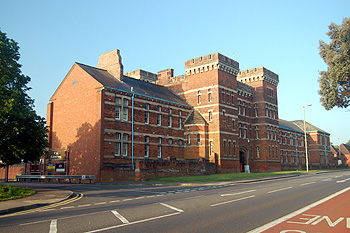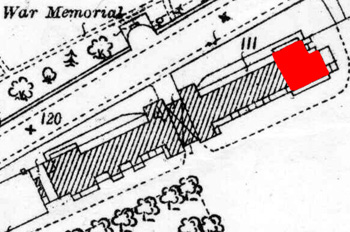Kempston Barracks

Kempston Barracks May 2012
Kempston Barracks, now known as The Keep, is one of the most impressive buildings in the county. It was listed by English Heritage in July 1998 as Grade II, of special interest.
The drawings for the barracks are dated 19th May 1874 [CRT130Kem22] and the building was completed in 1876, having been designed at the War Office by major H. C. Seddon, R. E. It is built in brick, with stone dressings and a slate roof. It is designed to resemble a castle in what is known as Fortress Gothic Revival Style. Part of the reforms to the army known as the Cardwell Reforms between 1868 and 1874 was designed to strengthen the local identity of infantry regiments (Regulation of The Forces Act 1871) and the building of barracks for the regiments in county towns was part of this. The 16th Regiment of Foot, which had had a connection with Bedfordshire since 1809, was officially named The Bedfordshire Regiment. On 1st August 1919 the title was changed to the Bedfordshire and Hertfordshire Regiment.
The 1885 Kelly’s Directory described the barracks, and said that they were “erected by Government in 1875-6, at a cost of about £50,000; the buildings form three sides of a quadrangle, and occupy 23 acres, enclosed by a high wall, 13 of which serve as encampment, drill and recreation ground; the east and west wings of the north front are connected by a central block with four massive towers, holding upwards of 3,000 stand of arms and accoutrements, in addition to a powder magazine, clothing and bedding stores; the west wing includes the officers’ mess, and quarters for eleven officers and their servants; the east wing consists of canteen, reading and recreation rooms, sergeants’ mess, four non-commissioned officers quarters, workshops and stores; the sides consist of two blocks, available for 288 soldiers (single) and eight sergeants; besides a hospital for 28 patients, four orderlies, residence for hospital sergeant and cook, and detached infectious ward and mortuary; there are also married soldiers’ quarters for 31 families, with an infant school attached”.
In October 1922 a soldier was killed by one of his comrades at the barracks. In the 1930s there were extensions, alterations and improvements, including new married quarters and sergeants’ mess but early in the 1939-1945 war the depot ceased to be a recruiting and training centre for the regiment, and during the war the barracks was used mainly as a convalescent centre, other functions having been transferred to Bury Saint Edmunds [Suffolk].
With the amalgamation with the Essex regiment in 1958 to form the Anglian Regiment (now the Royal Anglian Regiment) the depot was virtually closed. In 1977 the regimental records were moved from the barracks to Bedfordshire and Luton Archives and Records Service [X550].

The area of the main block demolished is shown in red
About 1982 a considerable part of the original buildings was demolished, and the site sold for housing. Most of the main block at the front was left, though the left hand end of was pulled down leaving a rather asymmetrical look to the building. Much of the area of the former barracks is now beneath modern housing (including Blenheim Court, Dunkirk Close, Flanders Close, Malakand Road, Montgomery Court, Normandy Close, Ramillies Close, Ryswick Road, Savannah Close, Walcourt Road ) though a Territorial Army Centre occupies part of the former site. At the time of writing [2013] the remaining building, The Keep, is used by freemasons.

The area of the original barracks shown in yellow